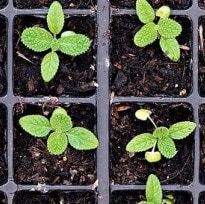There's a front garden on the way to my allotment filled with nothing but rosemary. On hot days it fills the street with its heady scent and sings with bees. The owners prune it every so often and bundle up the clippings for passersby. On my last haul I filled the kitchen with it, made salamoia bolognese for the winter and the remainders got bound into smudge stick air purifiers. I noticed recently that some of the rosemary in jars of water was starting to root, so there were free plants to boot. Rooting rosemary in water isn't ideal, though; equal parts grit and multipurpose compost will ensure much better results.
Perennial herbs such as rosemary, sage, lavender and thymes can live for a long time, but grow leggy and flop with age. The best option is to take semi-ripe cuttings of an overgrown plant now, when growth has started to slow and stems have hardened somewhat. These are thicker, tougher, hardier cousins to softwood cuttings. The hardened stems have a greater store of food and thus are more likely to survive, even in poor light levels.
You don't need heat for these cuttings, but a moist environment is a must, so you should cover seedlings with a plastic bag or propagator lid. You can leave them on a bright cool windowsill, in your greenhouse, polytunnel or cold frame, away from the worst weather, but avoid somewhere too warm as they will dry out too quickly. The cuttings will mostly root in late winter and early spring, though some will get a head start in autumn.
The simplest way to take them is to fill a plastic pot with equal parts grit and peat-free compost and cover the top with more grit or sand if possible. Cutting about 10-15cm long should be taken from this year's growth - soft and young at the top, but with a slightly thicker, woodier stem. This growth can come from main shoots or side shoots. Remove the leaves from the bottom 5cm and pinch out the soft tip. Insert the stem 3-4cm deep into the soil. The bottom leaves should sit above the soil. Space the cuttings around the edge of the pot and make sure they don't touch. Water well and place a clear plastic bag on top. Water if the soil dries out completely and protect them from hard frost. By spring, you'll see signs of new growth, pot on the successful ones to plant out in autumn.
Now is also the time to rejuvenate mint. Just pull the plant apart and repot the healthiest shoots (it's that simple). And there's still time to sow parsley and coriander for winter use. As these will need protecting over the winter, sow in pots that can moved somewhere frost-free.
Salvia Viridis 'Blue Clary' seedlings. Photograph: Alamy










